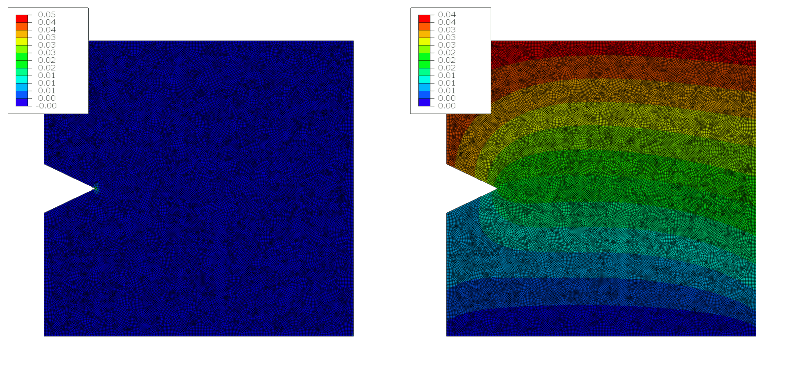In this case study, we hear from Vincenzo Brachetta (School of Metallurgy and Materials), who has been working on fracture mechanics in materials science using the high-performance cluster BlueBEAR and the Research Data Store, both housed at the University of Birmingham. He is also a member of the Birmingham Environment for Academic Research (BEAR) Champions group.
Professional profile

I am a researcher and computational scientist specialised in the study of complex physical-mathematical problems through numerical approximation. I hold a Master of Science in Construction Engineering with First-Class Honours and have completed a set of studies for a PhD at the School of Metallurgy and Materials, College of Engineering and Physical Sciences, University of Birmingham.
My recent research, among other interests, has concentrated on the finite element modelling of fracture evolution in mechanical components.
Problem setting
Fracture mechanics is a branch of engineering focused on the study of crack nucleation and propagation in materials, which occurs when the action of stress exceeds the strength of the material. Its study is fundamental for predicting component strength and ensuring an adequate mechanical response of parts under in-service conditions.
The capabilities of BlueBEAR are beneficial in all disciplines where an ordinary machine is not able to complete numerical tasks in a reasonable time
During the last decades, different computational techniques based on the finite element method have been developed to predict the evolution of fractures in a material, such as the extended finite element method (XFEM), although numerical modelling in this area remains a challenging and computationally expensive problem. The primary challenge stems from numerical instabilities caused by domain discontinuities associated with cracks. Recent approaches aim to mitigate this limitation by employing phase-field methods, which were originally used to investigate interfacial problems in metallurgy to predict how different phases (solid, liquid, gas, or other) develop, interact, and transform under various conditions. Theories have therefore been developed based on the mathematical analogy between phase interfacial problems and crack propagation in solids, beginning with variational formulations rooted in the classical work of Griffith on fracture mechanics (Griffith, A.A., ‘The Phenomena of Rupture and Flow in Solids’, Philosophical Transactions, Series A, Vol. 221, pp. 163-198, 1920).
BlueBEAR is crucial for all studies where researchers need to explore numerical models
The ongoing development of phase-field fracture mechanics is actively progressing within the scientific community, making it a highly dynamic area of research. Although these methods hold promise for overcoming computational limitations, computing speed remains a significant concern, necessitating the use of high-performance computing clusters to accelerate research and study. Three examples of simulations using a phase-field fracture mechanics formulation, developed in SIMULIA/Abaqus to investigate crack propagation in a bidimensional domain with different notches, are depicted in Figure 1, Figure 2, and Figure 3. In these examples, the domain is constrained at its base, with a displacement load incrementally applied at the top, whilst the other two faces remain unconstrained.



Technical details
Access to BlueBEAR is obtained through Putty, an open-source terminal emulator, which allows access to the GNU/Linux interface of the supercomputer. From the GNU/Linux Bash terminal, the simulation job can be submitted and monitored via Slurm Workload Manager, a free and open-source job scheduler. The job scheduler launches the simulations via SIMULIA/Abaqus, which can be linked to user subroutines written in Fortran.
Conclusion
BlueBEAR is crucial for all studies where researchers need to explore numerical models and try to better understand processes and material behaviour in order to achieve desired goals. Furthermore, the capabilities of BlueBEAR are beneficial in all disciplines where an ordinary machine is not able to complete numerical tasks in a reasonable time and thus overcome the limitations of standard computational machines.
We were so pleased to hear of how Vincenzo was able to make use of what is on offer from Advanced Research Computing, particularly to hear of how he has made use of BlueBEAR HPC and its many cores – if you have any examples of how it has helped your research then do get in contact with us at bearinfo@contacts.bham.ac.uk. We are always looking for good examples of use of High Performance Computing to nominate for HPC Wire Awards – see our recent winners for more details.
